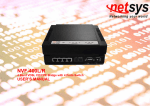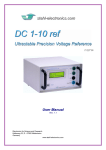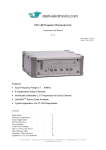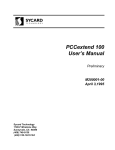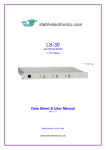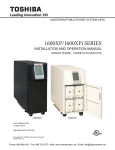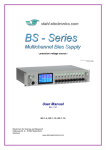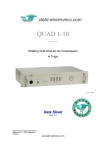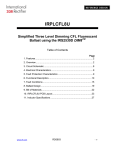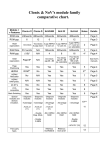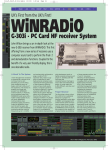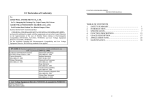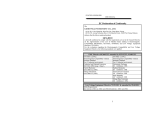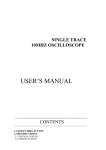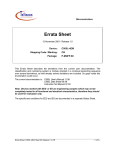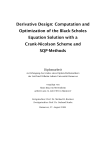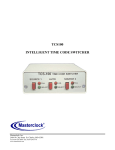Download User Manual
Transcript
HF-D series RF drive amplifiers for Ion Traps HFD_Drives_Manual_2_1.doc 28 - April - 2013 User Manual Rev. 2.1 Models HF-D 200, HF-D 425, HF-D 600 Main Features: ● ● ● ● ● RF drive amplifier for ion traps up to 600Vpp into 100pF load f = 360kHz to 1.5MHz, model dependent non resonant broadband design precision voltage stabilisation (device option) www.stahl-electronics.com HF-D User Manual, Rev 2.1 TABLE OF CONTENTS 1. Safety Hints ………………………………….…………………………………… 3 2. General Information and Overview………………….………………………….. 2.1 Purpose and Description of the Device…………………………….. 2.2 Functional Principle and Block Diagram…………………………. 4 4 4 3. Installation ……………………………………………………………………..… 5 3.1. Mechanical and Electrical Installation……………………………… 5 4. Operation and Control Elements ……………………………………………….. 6 4.1 4.2 4.3 Elements on the Front Plate………………………………………… Elements on Rear Side……………………………………………… Output Characteristics……………………………………………… 4.3.1 4.3.2 4.3.3 4.4 Stability and Fast Turn-On/Off Feature……………… 6 8 9 Output Harmonics…………………………………… Dipole Excitation…………………………………….. 9 10 10 Precision Output Amplitude Regulation …………………………… 11 5. Maintenance………………………………………….…………………………. 12 6. Specifications……………………………………………………………………. 13 Declaration of Conformity ………………………………………………………… 15 2 www.stahl-electronics.com phone: +49 6242-504882, fax: +49 6242 504884 HF-D User Manual, Rev 2.1 1. Safety Hints Read all installation, operation, and safety instructions Rear side switch turns device completely off This equipment must be connected to an earth safety ground Do not modify the unit Change cabling only when device is off Do not operate in wet/damp conditions Beware of external magnetic fields Service is to be performed by qualified service persons only Do not block chassis ventilation openings Operate carefully with respect to risk of electrical shock Routinely cleaning from dust No outdoor operation Prior to operation, thoroughly review all safety, installation, and operating instructions accompanying this equipment. If the device is not in use for a longer time, it is recommended to turn the mains switch at rear side off. This product is grounded through the grounding conductor of the power cord. To avoid electrical hazard, the grounding conductor must be connected to protective earth ground. Do not make electrical or mechanical modifications to this unit. Changing the cabling, when voltages are present at the outputs can lead to formation of harmful sparks. To avoid electric shock hazard, do not operate this product in wet or damp conditions. Protect the device from humidity and direct water contact. External magnetic fields can impair, damage or even destroy this device. A maximum external field strength of no more than B = 5mT is admissible. Having placed the device at any time into an external magnetic of bigger B = 5mT (regardless if power was turned on or off) can lead to severe overheating of the device and severely increased hazard of fire. All servicing on this equipment must be carried out by factory-qualified service personnel only. Slots and openings in the chassis are provided for ventilation purposes to prevent overheating of the equipment and must not be restricted. All case vents should continuously be cleared (fan inlets at rear side, air outlets on top side), in order to prevent overheating. If mounted in a rack, allow 4cm clearance at the top cover with respect to the next device above. This device can produce high voltages at its output lines, which are harmful in case of direct touch with the human body. Care must be taken to avoid unintentional touching of any output line or connection to any device which might be endangered by high voltages. After long operation, or operation in a dusty environment it is strongly recommended to have the internal parts of the device cleaned by the manufacturer, or an appropriately qualified workshop in order to reduce the hazard of overheating. Outdoor operation of the device is not admissible. 3 www.stahl-electronics.com phone: +49 6242-504882, fax: +49 6242 504884 HF-D User Manual, Rev 2.1 2. General Information and Overview 2.1 Purpose and Description of the Device Purpose of the RF drives HF-D 200, HF-D 425 and HF-D 600 is the supply of AC voltages to Paul Ion Traps and other Quadrupole-type electrode setups for ion storage and manipulation. Unlike standard RF (radio- frequency) power amplifiers, the device is capable to handle capacitive loads, which are related to vacuum setups for ion trapping and storage. The devices feature a fast-turn-on/off capability to capture ions in flight. Other common RF drives usually require a certain amount of time to build up the nominal output voltage since they are based on a resonant voltage transformation. In contrast the RF drive HF-D series consists of broadband devices which allow for instant turn-on and fast turn-off of the AC output voltage. For example, the HF-D 200A is designed to deliver up to 200Vpp AC voltage of 600kHz to 1.5MHz frequency into a 100pF load on each output, the HF-D 600 is designed to deliver up to 600Vpp AC voltage of 300kHz to 600kHz frequency into a 100pF load on each output. The devices are housed in a standard 19-inch rack-mount case. Fig. 2.1: RF drive HF-D 200A, trapping field generator in 19”-case. 2.2 Functional Principle and Block Diagram The following picture displays a block diagram of the internal structure, illustrating the functional principle. The voltage at the main signal input controls a fast electronic switch, which switches between the high and low level of the external supply voltage, creating a rectangular shaped high voltage signal. The rate at which this switching happens is defined by the frequency at the signal input (for instance 600kHz). A subsequent sine wave filter removes the higher harmonics, thus creating a sine-shaped high voltage waveform. The DC level of the externally supplied DC voltage at rear input defines the devices output AC level, since both voltages are in linear relation. This also means that output regulation of the device AC level is done by choosing the appropriate input high voltage DC supply level. Fig. 2.2: Block diagram of internal circuitry 4 www.stahl-electronics.com phone: +49 6242-504882, fax: +49 6242 504884 HF-D User Manual, Rev 2.1 As shown in the block diagram, an additional DC offset may be added to the output sine wave. This voltage is applied at the rear side and adds linearly to the output sine, therefore shifting its DC level. Furthermore an excitation signal may be applied, which also adds to the trapping field. This add-on signal is split in to an in-phase and 180°-shifted part. Both parts are added to the trapping field, and the sum/difference is subsequently available on the two BNC output plugs (denominated as outputs A and B) on the rear side. This feature is specially suited for creating an AC dipolar field in the order of a few Millivolts to a few Volts inside an attached ion trap. Note, that the dipolar excitation signal, being applied on the front side of the device is attenuated or amplified to a certain degree. Figure 4.8 shows the frequency response of this dipolar signal in terms of the voltage difference at the outputs A-B versus frequency, at a given input excitation amplitude. 3. Installation 3.1 Mechanical and Electrical Installation Positioning: Provide sufficient air cooling of the device and locate in normal horizontal position to allow for defined air convection. Rack mounting into a standard 19” rack is as well possible as resting the device on a table. If mounted in a rack, allow 4cm clearance at the top cover with respect to the next device above. All case vents must permanently be cleared (inlet at rear side and air outlet at top side), in order to prevent overheating. Please note that the device may experience serious damage in case sufficient air ventilation is not given. Fig.3.1 Air vents (marked blue) must all be kept clear to ensure sufficient ventilation. Under no circumstances the vent slits must be blocked, since they are vital for device operation in order to prevent overheating. Beware of external magnetic fields: Strong external magnetic fields can impair, damage or even destroy this device (e.g. proximity to a superconducting magnet). A maximum external field strength of no more than B = 5mT is admissible. Not observing this important condition can lead to severe overheating of the device and increases the hazard of fire. Connecting to mains power: Connect the device to the mains power supply by using an appropriate power cord, being properly wired and providing a grounded outlet. The power cord must be suited with respect to possible load currents and should be rated to 2A current. Cabling of voltage outputs: Always provide appropriate and safe cabling when connecting the device to other devices or vacuum/experimental setups. Cabling is preferred using a high voltage low-capacitance cable with proper shielding. A suitable choice of cable type is e.g. a RG62 type, which has a small parasitic capacitance of approx. 48pF/m, half the value of standard RG58 BNC cable. The smaller parasitic capacitance allows a higher degree of freedom since cable capacitance significantly contributes to the overall (terminal) capacitance, which must not exceed 100pF (each output) to meet the device specifications. 5 www.stahl-electronics.com phone: +49 6242-504882, fax: +49 6242 504884 HF-D User Manual, Rev 2.1 4. Operation and Control elements 4.1 Elements on the front plate Input Mains Supply Switch Input Enable Range Selector Output Voltmeter Dipole Excitation Fan/Temperature Warning Figure 4.1: front plate and operating elements The front plate contains the main control elements of the device: Mains Supply Switch The device is powered up after activating the rear-side mains supply switch and switching the power button on the front plate into the “on” position. A Power-on-LED (green) indicates proper operation of the internal circuitry. A warning beeper will temporarily sound, which is used for ventilation fan-speed monitoring. If the warning beeper permanently sounds, the device must not be put into operation. In general, if the device is not in use for a longer time, it is recommended deactivate the rear side mains switch to cut the device completely off from mains supply. This is mainly for safety reasons. Input The input signal (sine wave) is fed into the BNC input at the front side (75 input impedance nominally). An AC voltage level of nominally 5Vpp should be applied. The LED indicator above the BNC socket lightens up green, if a sufficiently large signal level is applied, red otherwise (i.e. input AC voltage too small). The waveform of the applied signal should be “sine” to allow for proper operation and meeting of the specifications in chapter 6. This input may be fed by a common function generator or radio frequency (RF) signal source. Please make sure that the device is not permanently operated with input voltage being too low (LED indicator red). Note that the output voltage is not supposed to be controlled by the amplitude value of this input, but by variation of the DC supply on rear side (see section 4.2). The latter supply voltage is in good approximation proportional to the output AC voltage. Once the device is installed and cabled in a given setup, it is recommended to choose the input voltage level to be approx. 15% higher than the transition threshold (red-to-green) of the level indictor LED. A second LED indicator above the one mentioned before lightens up green if the external DC supply voltage exceeds approximately 150V to 180V, showing the presence of DC voltage at the rear side. Enable The “Enable” section of the device allows to turn the output power completely on or off. This section consists of a manual switch, a disable BNC input and status indicator. The output power of the device is either enabled or disabled (LED indicator shows green or red light). The user may select this state by choosing the desired switch position manually (putting it up or down), or by applying an external signal of logic level to the corresponding BNC input. When the manual switch lever is centered, a logic “LOW” level (0 Volts) disables, a logic level “HIGH” (+5 Volts) enables the RF outputs. The reaction time upon a change of this level is about 1 to 2 signal periods (see also section 4.3.1) 6 www.stahl-electronics.com phone: +49 6242-504882, fax: +49 6242 504884 HF-D User Manual, Rev 2.1 Range Selector For proper operation of the internal sine wave filter, the frequency range selector knob must be placed in the appropriate position, depending on the input frequency chosen. Avoid running the device permanently in the wrong position, since this may load the internal device circuitry after some time due to excessive heat production. Fan/Temperature Warning In case there is a problem with the ventilation fans or signs of overheating inside the device, the latter is indicated by red warning LEDs. In case they lighten up, the output is intentionally disabled for safety reasons and a warning beeper will sound. Output Voltmeter The Output Voltmeter shows the output AC voltage in terms of Volts-peak-peak. It averages over the two outputs A and B (rear side of device). Note, that one always has to ensure by choosing an appropriate DC supply level at the rear side, that the output level does not constantly exceed its nominal value of 200Vpp, 425Vpp or 600Vpp respectively. Note that otherwise the device may overheat and get damaged. Therefore always carefully watch this indicator when changing the external DC supply voltage or changing other conditions of devices attached (e.g. cabling). Excitation Input and Test Output At the BNC test output socket (placed on rear or front side), one can check the general functionality of the device. 1/100 of the output amplitude, being averaged over the two outputs A and B is provided here. This applies for AC components as well as the (optional) DC-Offset. The excitation input allows for adding a voltage difference between the two outputs A and B. This voltage is linearly superposed to the RF field. A voltage up to 20Vpp may be applied here. Please observe the frequency response (fig. 4.7) i.e. the transfer function has a certain frequency-dependency. The “unbalanced” LED indicator above the excitation socket lightens up if a large AC voltage difference (greater roughly 15Vpp) between the outputs A and B is detected. It therefore lightens up in case of an intentionally applied excitation signal, or if there is a malfunction, e.g. an unbalanced capacitive or resistive load on the outputs A or B. This indicator may serve as coarse, but nevertheless important, check for correctly attached cables and circuitry on the outputs. However, a thorough cabling check is recommended before applying any signals to the outputs (see below, section 4.2). 7 www.stahl-electronics.com phone: +49 6242-504882, fax: +49 6242 504884 HF-D User Manual, Rev 2.1 4.2 Elements on rear side Output A Output B Fuse Test Output Offset Input DC Supply positive supply switch DC Supply negative Case GND Figure 4.2: rear plate elements. Not that the device may have an additional BNC output for installing a regulation loop in order to keep the AC output voltage level constant (see text below). The rear side contains the following elements: Output A and B Both outputs (BNC sockets) feature the same phase and amplitude of the created RF driving field, i.e. voltages from 0 to 600Vpp at frequencies between 360kHz and 630kHz in case of the device HF-D 600. Their only difference is an optional potential difference, regarded as dipolar excitation (see section 4.1 and the overview in section 2.2). In case this feature is not needed, one may directly join outputs A and B together at the rear side of the device and guide this trapping voltage with a single cable to the experimental setup (this is not the case if one output is intentionally disabled). Otherwise two separate cables are required, being connected to corresponding split trap or quadrupole electrodes. Attention: Before operating the device, a thorough check of the cables connected to the outputs A and B is mandatory due to the high voltages and high associated electric power. Therefore verify with a multimeter before connecting to the device, whether ● the attached cables on outputs A and B feature a high resistance to GND, i.e. >10MOhm including the completely connected vacuum setup (ion trap, quadrupole setup), ● the attached cables have a capacitance to GND smaller 100pF each. In case both outputs are connected together, the maximum capacitive load is 200pF1). ● the attached capacitance to GND of cables including connected vacuum setup should be equal, i.e. the terminal capacitance should match by better than 5% Device operation assumes that these boundary conditions are met. Otherwise, in case of a significant resistive load or capacitive load greater 100pF per output, the device may not reach the desired output voltages and furthermore may be damaged by thermal overload during permanent operation. Connect the cables to the device and turn it on only if the above points have been checked and are fulfilled. Remark1): Smaller capacitances are preferable in terms of long device life time and smaller power consumption. The recommended load on each output is no more than 70pF. Offset Input The Offset Input allows for adding an additional (externally provided) offset to both output lines. This offset is linearly added (superposed) and may reside in the range between -300V and +300V. Note, that 8 www.stahl-electronics.com phone: +49 6242-504882, fax: +49 6242 504884 HF-D User Manual, Rev 2.1 this input is not intended for fast changes (pulsing) of voltages. In case left open, an offset of zero volts is added, i.e. the sine waveform of outputs A and B is centered around zero volts. Input impedance at this input is nominally 1M + 25pF vs. GND. The applied voltage is internally diminished by roughly a factor of 0.85 before being fed to the outputs. Negative and positive external supply and GND Connect these terminals to an external high voltage supply, being capable of delivering a stabilized voltage and sustain a certain DC current, e.g. a stahl-electronics HVD-series supply or other suited. This externally supplied voltage defines the AC output voltage of the device, and is therefore of decisive importance. In case the external DC voltage supply has a GND line, connect the latter to the GND terminal for minimizing of unwanted noise pickup. All three terminals are standard laboratory (4mm) sockets. The required voltages and currents to achieve a certain AC output voltage depend on the capacitive load on the outputs, the frequency and voltage. Figures 6.1 and following show typical characteristics for HF-D series devices at capacitive loads. Note that the depicted data are obtained using a symmetrically split supply voltage, e.g. 400VDC being split into + and - 200VDC at the red and black socket on the rear side. Using a non-symmetric supply, e.g. positive or negative terminal grounded, is also possible, but increases the current consumption typically by 15 to 20%. Important: When commissioning the device, it is recommended to start with a low DC supply voltage (e.g. 30V) on the rear side terminals after completion of the cabling (see above) and gradually increase it. During this time one should monitor, if the output voltage is built up as expected or if any problems occur. Essentially the voltage/current characteristics like shown in figure 6.1 apply, and they scale linearly with supply voltage. Therefor using a small supply voltage at the beginning will prevent excessive heat dissipation in case of wrong cabling or other problems. One should not take the risk to turn the device on to full power (maximum voltage) after the trap/electrode setup had been changed substantially. Always perform a thorough cabling check like mentioned above before trying to apply large voltages. 4.3 Output Characteristics 4.3.1 Stability and Fast Turn-On/Off Feature The outputs A an B provide a sinusoidal waveform with identical amplitude and phase. Phase jitter and amplitude jitter are in the order of < +/-1°, and about 2x 10-3 relative to the output amplitude, respectively. Note that instability of the externally supplied DC high voltage will add fluctuations to this intrinsic amplitude instability. Figure 4.3 Theoretical waveform: the non-resonant design allows for immediate response (turn-on / turn-off) of the high frequency output 9 www.stahl-electronics.com phone: +49 6242-504882, fax: +49 6242 504884 HF-D User Manual, Rev 2.1 Figure 4.4 Experimentally measured waveforms during turn-on / turn-of events; f = 350kHz, Uout = 380Vpp. The HF-D amplifiers feature immediate turn-on characteristics as shown above, due to their inherent broadband design. The remaining waveform tails during turn-on/off events typically last for about one signal period. The transient waveforms shown in the figure above were obtained using the “external enable” input on the front plate. Please note that the output amplitude at high amplitudes >150Vpp may show significant drift in time due to internal heating effects with a typical time constant of 30 minutes. This drift (decreasing amplitude) may be in the order of several percent after starting the device operation, unless an external correction loop is implemented (see below). 4.3.2 Output Harmonics The output waveform is essentially a sine wave with some remains of higher harmonics. The subsequent graphs depict the signal’s harmonics content in dB with respect to the main (fundamental) frequency, which are a left-over from the sine-forming process. Figure 4.5 Strength of residual signal harmonics in dB with respect to fundamental frequency, HF-D 200A device. Figure 4.6 Strength of residual signal harmonics in dB with respect to fundamental frequency, HF-D 600 device. 10 www.stahl-electronics.com phone: +49 6242-504882, fax: +49 6242 504884 HF-D User Manual, Rev 2.1 Figure 4.7 Strength of residual signal harmonics in dB with respect to fundamental frequency, HF-D 425 device. 4.3.3 Dipole Excitation The Dipole excitation input on the front plate can be used to create a voltage difference between the two outputs A and B, see also fig. 2.2. This voltage, being in the order of a few volts, may be used to excite motion or energy of trapped ions. Observe, that the internal circuitry features a certain transfer function, which is shown in the subsequent figure. For instance applying a voltage of 10Vpp at 300kHz will create a voltage difference of 15Vpp at the outputs. Maximum output voltage difference is approximately 20Vpp. Beyond that value the circuitry will get into saturation. 1,8 figure 4.8 Dipole excitation transfer function, i.e. ratio of output voltage-difference to excitation input voltage, a sine wave is assumed. Dipole transfer function 1,6 1,4 1,2 1,0 0,8 0,6 0,4 1 10 100 1000 10000 Frequency (kHz) 4.4 Precision Output Amplitude Regulation In case the corresponding option is installed, the device features a BNC output at the rear side (marked in left picture) , at which a DC-voltage, being proportional to the AC output amplitude is presented. The corresponding scaling factor is approximately 1VDC per 200VAC on the AC outputs. By using this DC output voltage, an external correction loop may adapt and continuously modify the supply high voltage to keep the magnitude of AC output signal constant. This eliminates temporal and temperature-related drifts of the AC amplitudes. Typically a stability on a 0.25%-level is reached that way. E.g. dedicated stahl-electronics HVD-series supplies support this functionality. Please refer to their data sheets or manuals for more details. 11 www.stahl-electronics.com phone: +49 6242-504882, fax: +49 6242 504884 HF-D User Manual, Rev 2.1 5. Maintenance The HF-D 200A device is designed for long-term reliable operation. Under normal operating conditions, it should not require electrical maintenance, except routine cleaning of dust. Exchange of ventilation fan is strongly recommended every 50’000 operation hours (see below). If any question should arise, please contact the manufacturer. Routine cleaning All ventilation openings – top, sides, and rear panel – should be checked periodically and must be kept free of dust and other obstructions. A vacuum cleaner may be used to clean these vents when the unit is powered off. The front panel may be cleaned periodically with a clean cloth and mild alcohol solution. Fan life time and fire hazard The air ventilation fans are parts which show unavoidable deterioration in time. Exchange is recommended after 50’000 hours of operation. Please contact manufacturer for replacement. Complete failure can lead to overheating of the device, causing malfunctions and risk of fire. Temperature fuses and other protection measures provide a certain degree of safety against fire hazard, however a proper cooling of the device is essential. Please note that excessive accumulation of dust inside the device also can lead to overheating. This increases the risk of fire. Routinely cleaning the device from dust minimizes this risk. It is therefore recommended to routinely perform cleaning from dust in latest 2-year intervals, by an accordingly qualified electronics workshop. Decommissioning Decommissioning of the device is recommended after 130’000 hours of operation. Please contact manufacturer for appropriate waste disposal and observe applicable legal regulations. 12 www.stahl-electronics.com phone: +49 6242-504882, fax: +49 6242 504884 HF-D User Manual, Rev 2.1 6. Specifications Input Specification nom. 5Vpp (Volts-peak-peak), 4.5Vpp to 8Vpp applicable without damage, nom. 75 input, ac coupled recommended signal level: 15% higher then LED indicator green-red transition Input voltage level Output Specifications Output voltage HF-D 200A HF-D 425 HF-D 600 Frequency range HF-D 200A HF-D 425 HF-D 600 Output connector type (unless customized) DC Offset 0 to 200Vpp (Volts-peak-peak) = 70.7Vrms 0 to 425Vpp (Volts-peak-peak) = 150.3Vrms 0 to 600Vpp (Volts-peak-peak) = 212.1Vrms 600kHz to 1.5MHz 450kHz to 900kHz 360kHz to 630kHz BNC max. +/-300V DC (applied to rear side BNC offset input) Capacitive load capability 1/100 Test Output Delay with respect to outputs A and B Scaling Error Dipole Excitation Input (front plate) max. 100pF, ≤ 75pF recommended typical 35ns maximum 3% 8% 0 to 10Vpp, 50 < 12Vpp Output (rear side) see figure 4.6 (sine wave assumed ) 20Vpp @ ≤100pF load Front Plate Digital Voltmeter Reading (Volts-peak-peak) Accuracy: Scale error Offset error typical 0.5% 2V maximum 2% 3V Environmental Conditions Magnetic Field Storage Temperature Operating Humidity & Temperature max. 5mT admissible -55 °C to +85 °C noncondensing relative humidity up to 95% temperatures between +10°C to +30°C. Power Supply AC Supply Rating External DC Supply AC input voltage 230VAC at 50Hz or 60Hz. The power entry module is EMI/RFI-filtered. Fuse: medium fast blow 2x 0.8A typ. 12W consumption typ. 200V to 600V DC, see figure 6.1, 6.2, 6.3 13 www.stahl-electronics.com phone: +49 6242-504882, fax: +49 6242 504884 HF-D User Manual, Rev 2.1 specifications continued 19.00” wide x 10” deep. Front-panel mounting holes are configured for M6 rack configurations approximately 5.6 kg Case dimensions Weight . Figure 6.1 a and b: required externally supplied DC voltage and current consumption to obtain 200Vpp output amplitude with 100pF load capacitance each output, device HF-D 200A. Both graphs are split in a lower and upper frequency band, according to the position of the range selector knob. 500 100 450 90 400 Supply current (mA) Supply voltage (V) Figure 6.2 a and b: required externally supplied DC voltage and current consumption to obtain 600Vpp output amplitude with 100pF load capacitance each output, device HF-D 600. Both graphs are split in a lower and upper frequency band, according to the position of the range selector knob. 350 300 250 200 150 100 400 600 800 80 70 60 50 40 400 1000 600 800 1000 Fr equency (kHz) Fr equency (kHz) Figure 6.3 a and b: required externally supplied DC voltage and current consumption to obtain 425Vpp output amplitude with 70pF load capacitance each output, device HF-D 425. Both graphs are split in a lower and upper frequency band, according to the position of the range selector knob. 14 www.stahl-electronics.com phone: +49 6242-504882, fax: +49 6242 504884 HF-D User Manual, Rev 2.1 DECLARATION OF CONFORMITY Manufacturer's Name: Dr. Stefan Stahl - Electronics for Science and Research - Manufacturer's Address: Kellerweg 23 67582 Mettenheim Germany. Declares, that the product Product Name: Model Numbers: RF Drive for Paul Traps HF-D Series HF-D 200A, HF-D 425, HF-D 600 Product Options: This declaration covers all options of the above product(s) Conforms with the following European Directives: The product herewith complies with the requirements of the: 1. Low Voltage Directive 73/73EEC; 2. EMC Directive 89/336/EEC (including 93/68/EEC) and carries the CE Marking accordingly Date Of Issue __________________ 5. January 2013 General Director 15 www.stahl-electronics.com phone: +49 6242-504882, fax: +49 6242 504884















